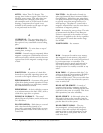
Glossary
Quickview 300 80/100/120/160/200/250/300GB PATA G-7
REMOVABLE DISK – Generally said of
disk drives where the disk itself is meant to be
removed, and in particular of hard disks using
disks mounted in cartridges. Their advantage
is that multiple disks can be used to increase
the amount of stored material, and that once
removed, the disk can be stored away to
prevent unauthorized use.
RLL – Run Length Limited. A method used
on some hard disks to encode data into
magnetic pulses. RLL requires more
processing, but stores almost 50% more data
per disk than the MFM method.
ROM – Acronym for read only memory.
Usually in the form of an ROM in the
controller that contains programs that can be
accessed and read but not modified by the
system.
ROTARY ACTUATOR – The rotary
actuator replaces the stepper motor used in the
past by many hard disk manufacturers. The
rotary actuator is perfectly balanced and
rotates around a single pivot point. It allows
closed-loop feedback positioning of the heads,
which is more accurate than stepper motors.
ROTATIONAL LATENCY – The delay
between when the controller starts looking
for a specific block of data on a track and
when that block rotates around to where it
can be read by the read/write head. On the
average, it is half of the time needed for a full
rotation (about 8 ms.).
S
SCSI – Acronym for Small Computer System
Interface, an American National Standards
Institute (ANSI) version of Shugart Associates'
SASI interface between the computer and
controller. SCSI has grown in popularity and
is one of the most flexible and intelligent
interfaces available.
SECTOR – A section of space along a track
on the disk, or the data that is stored in that
section. Hard disks most often have sectors
that are 512 data bytes long plus several bytes
overhead for error correcting codes. Each
sector is preceded by ID data known as a
header, which cannot be overwritten.
SEEK – A movement of the disk read/write
head in or out to a specific track.
SERVO DATA – Magnetic markings
written on the media that guide the
read/write heads to the proper position.
SERVO SURFACE – A separate surface
containing only positioning and disk timing
information but no data.
SETTLE TIME – The interval between
when a track to track movement of the head
stops, and when the residual vibration and
movement dies down to a level sufficient for
reliable reading or writing.
SHOCK RATING – A rating (expressed in
Gs) of how much shock a disk drive can
sustain without damage.
SOFT ERROR – An error in reading data
from the disk that does not recur if the same
data is reread. Often caused by power
fluctuations or noise spikes.
SOFT SECTORED – Disks that mark the
beginning of each sector of data within a track
by a magnetic pattern.
SPINDLE – The center shaft of the disk
upon which the drive’s platters are mounted.
SPUTTER – A type of coating process used
to apply the magnetic coating to some
high-performance disks. In sputtering, the
disks are placed in a vacuum chamber and the
coating is vaporized and deposited on the
disks. The resulting surface is hard, smooth,
and capable of storing data at high density.
Maxtor disk drives use sputtered thin film
disks.
STEPPER – A type of motor that moves in
discrete amounts for each input electrical
pulse. Stepper motors used to be widely used
for read/write head positioner, since they can
be geared to move the head one track per
step. Stepper motors are not as fast or reliable
as the rotary voice coil actuators which
Maxtor disk drives use.


















